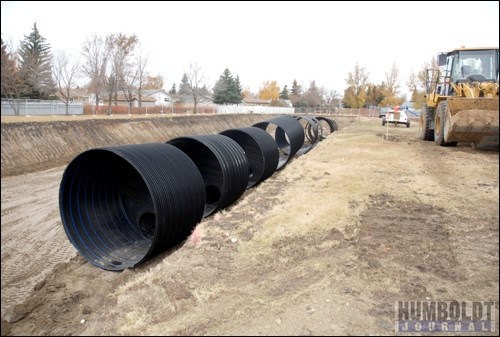Together, they will form a pipe. And they are super big.A.E. Kilcher Park on Humboldt's northwest side doesn't look much like a park these days. It's crawling with heavy machinery and construction workers working on a superpipe infrastructure project.Most of the park is still littered with over 50 sections of huge, plastic pipe.And we mean huge - each section of pipe is three metres in diameter and 110 metres long.That's big enough to dwarf a fully grown man standing inside. These huge sections will soon be buried beneath the surface of the park, and will offer over 2,000 cubic metres of storm surge holding capacity.That should eradicate the issue of basements in the area around the park getting flooded during storms. Joe Doxey, director of engineering and planning for the City of Humboldt, took the Journal on a tour of the park/construction site last week. The huge pipe system under the park will handle storm water that infiltrates the sanitary sewer system, he explained.At the time of our visit, a crew was working between the sewer lift station at the south end of the park and the street next to it, tying the park project into the existing system. With this new system of pipes in the park, during a storm event like the one that occurred in early 2010 which resulted in sewer backups and flooding in many basements in the area, when storm water infiltrating the sanitary sewer system gets to a certain height, it will flow into the pipes in the park instead of people's basements, Doxey explained. The pipe in the park will actually be lower than the lowest basement.After the storm is over, the water in the superpipes in the park will slowly drain out into the main system again."It's a big pipe that acts like a tank," Doxey said. Each section of pipe costs between $15,000 and $20,000 and are specially made, Doxey said, as he stood next to those still above ground in the park. Once the pipes are installed and covered up, there won't be any evidence of them, except for some vents at the north end of the park. They ended up having to angle the pipe across the park in order to keep those vents away from the playground equipment and the soccer field, Doxey said, explaining why they dug the hole for the pipes at an angle. They did have to take out a couple of maple trees to allow for the vents, Doxey said, which was a shame but had to be done. Some of the other trees in the park may have to come down as well, before the project is complete, he indicated. The vents, he added, shouldn't smell at all. More or less, any water that's in the superpipe will be rain water, and that water won't be sitting in them as a regular occurrence. This system should ensure that basement flooding that has been widespread during heavy rainfall in the past few years doesn't happen again.The City has been keeping an eye on water levels since the storm in the spring of 2010, and nothing has come close to it, Doxey noted. There have been some high levels, but they've still had a buffer left. The superpipe project should be complete by the end of November. Next summer, they will focus on restoring the park, which has had heavy machinery trampling whatever grass was not torn up.

.png;w=120;h=80;mode=crop)


